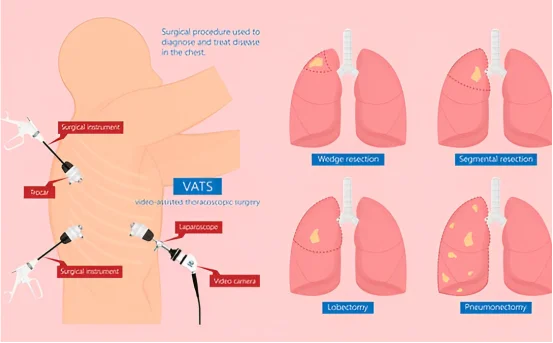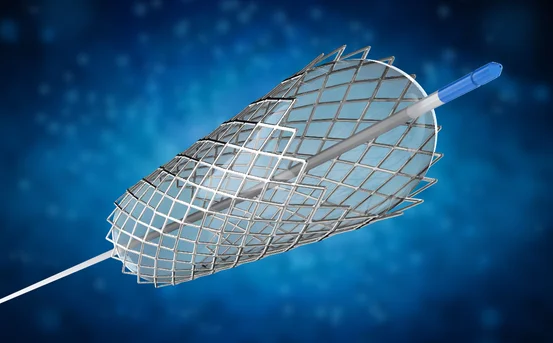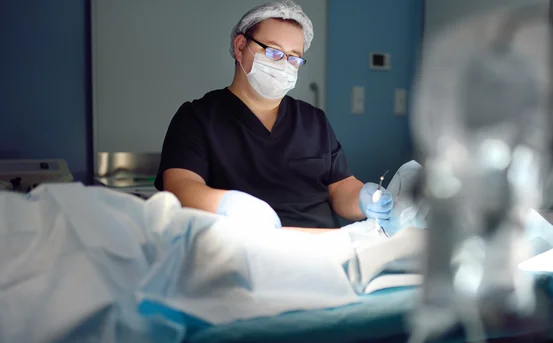The Wedge Resection Surgery is a type pulmonary surgery in which a small wedge-shaped part of the lung can be removed to diagnose or treat various pulmonary disorders. Patients with benign lung nodules or localized infections, as well as those in the early stages of lung cancer, are often advised to undergo this procedure. The symptoms for wedge resection surgery is a minimally-invasive procedure that offers many advantages over more extensive procedures such as lobectomy. These include preserving more lung tissues and a faster recovery.
As with any surgical procedure however, patients should be aware that wedge resection can cause specific post-operative side effects. These symptoms for wedge resection surgery will help you manage expectations, detect complications early and ensure a smooth recovery.
What is Wedge Resection?
The wedge resection is an invasive surgery that saves the lungs. A triangle-shaped segment of abnormal lung tissue and a healthy margin are removed. Video-assisted-thoracoscopic-surgery (VATS) and robot-assisted-surgery are both less invasive than traditional open surgery.
Common indications for wedge resection:
- Early-stage non-small cell lung cancer (NSCLC)
- Nodules or lesions of the lungs that are isolated
- Lung abscesses or infections
- Lung biopsy as a diagnostic tool
- Metastatic tumours of the lung
Why Is Wedge Resection Performed?
The following situations are typical of when wedge resection would be recommended:
- Diagnosis of Lung Cancer and Treatment :- Patients with stage I lung carcinoma who do not qualify for a lobectomy because of age, poor lung functioning, or any other medical concerns are often given this option as the first surgical option.
- Benign Lung Nodules :- Patients with suspected lung nodules who have not had a definitive diagnosis confirmed through imaging or biopsy can benefit from wedge resection to obtain a tissue sample that will allow a histopathological determination.
- Localized Lung Infection or Injury :- When a lung segment is badly damaged by trauma or infection, wedge resection can be used to remove the affected area without compromising lung function.
Common Symptoms After Wedge Resection Surgery
Understanding the Symptoms for Wedge Resection Surgery
Although wedge resections are less invasive than other surgical procedures, some patients still experience post-operative symptoms. These symptoms are temporary, but they should be closely monitored.
Chest pain and discomfort :- After surgery, it is not uncommon to feel mild to moderate pain in the chest area. This usually occurs near the site of incision. The pain may become more intense when you take deep breaths or cough.
- What causes it: The placement of chest tubes and surgical manipulation of lung tissues can cause irritation of nerves and muscle.
- Management: Breathing exercises, pain relievers and mobility are all helpful in recovery.
Dyspnea (shortness of breath) :- Patients may feel short of breath for several days or even weeks following surgery, especially when exerting themselves.
- Why it happens: It takes time for the lungs to compensate and adjust.
- Treatment: Rehabilitation of the lungs through breathing therapy or pulmonary rehabilitation is recommended.
Fatigue and weakness :- After major surgery, such as wedge resection, it is common to feel tired and depleted of energy.
- Why it happens: Anesthesia can cause lingering effects, as the body redirects its energy to healing.
- Management: Rest, nutrition and moderate physical activity.
Coughing
- After wedge resection, a persistent wet or dry cough can occur.
- Coughing can be caused by a combination of healing tissues in the lungs, irritation from intubation and anesthesia.
- Treatment: Steam inhalation and cough suppressants. Follow your surgeon’s instructions.
- Drainage of Chest Tubes :- Chest tubes may be used to remove fluids and excess air from the lungs. Expect some minor discomfort or slight leakage at the site of insertion.
- Less Common or Concerning Symptoms :- Some symptoms may be normal after surgery, but others could indicate complications that require immediate medical attention.
- High fever (over 100.4degF/38degC). :- This may indicate a lung infection or an infection at the surgical site.
- Increased or worsening pain :- If you experience persistent or increasing pain that is not relieved by medications, it could be a sign of complications such as fluid accumulation or nerve involvement.
- Rapid or Difficult Breathing :- May suggest lung collapse (pneumothorax) or fluid accumulation.
- Bleeding and Unusual Drainage :- A chest tube that is discharging blood in a bright red color or smelling foul can be a warning sign.
- Swelling and pain in the legs :- This could indicate a deep vein embolism, which can lead to a PE.
Recovery Timeline and Tips
The recovery from wedge resection depends on many factors, including the patient’s health overall, their lung function and the surgical technique.
- General Recovery Milestones
- Average hospital stay: 2-5 Days
- Return to normal activity: 4-6 Weeks
- Improved lung capacity over several months
Recovery Tips
- Follow pulmonary rehabilitation programs
- Smoking or second-hand smoke should be avoided
- Keep active by light walking
- Use a spirometer incentive regularly
- Consume a diet rich in protein and anti-inflammatory
Conclusion
The wedge resection procedure is a lifesaving surgery that can be used to diagnose and treat localized lung diseases or cancers in the early stages. Although the surgery is relatively safe and the recovery time is shorter than other more invasive procedures, it is important to be aware of common symptoms following wedge resection.
It is normal to experience symptoms such as mild coughing, shortness-of-breath, fatigue and chest pain. However, these should improve gradually with the proper postoperative care. Consult your doctor immediately if you have any unusual or severe symptoms.
Knowing the symptoms to expect and when to seek assistance will ensure that you have a successful recovery. You’ll also enjoy peace of mind on your healing journey.























